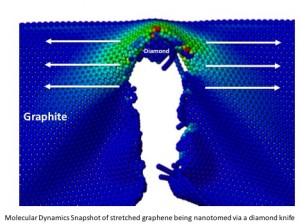I got an email this morning (May 22, 2012) informing me that an article, Two centuries of memristors by Themistoklis Prodromakis, Christofer Toumazou and Leon Chua, had just been published in the journal Nature Materials. The article situates memristors in an historical context stretching back to the 19th century. Sadly, the article is behind a paywall so I won’t be copying too much material but I will attempt to give you the flavour of the piece.
The focus is on 19th century scientists and their work with what we are now calling ‘memristors’. Before moving on to the article, here’s a good definition of a memristor, from the Wikipedia essay (note: I have removed links and footnotes),
Memristor (… a portmanteau of “memory resistor”) is a passive two-terminal electrical component envisioned as a fundamental non-linear circuit element relating charge and magnetic flux linkage. The memristor is currently under development by a team at Hewlett-Packard.
When current flows in one direction through the device, the electrical resistance increases; and when current flows in the opposite direction, the resistance decreases. When the current is stopped, the component retains the last resistance that it had, and when the flow of charge starts again, the resistance of the circuit will be what it was when it was last active. It has a regime of operation with an approximately linear charge-resistance relationship as long as the time-integral of the current stays within certain bounds.
This Wikipedia essay also offers an historical timeline, which starts in 1960 with Bernard Widrow and his memistor, adding very nicely to the discussion in the Nature Materials article which focuses on such 19th luminaries as Sir Michael Faraday, Hertha Ayrton, Alessandro Volta, and Humphry Davy, amongst others. Here’s a helpful description of hysteresis and how it relates to the memristor from the article (note: I have removed footnotes),
The functional properties of memristors were first documented by Chua and later on by Chua and Kang, with their main fingerprint being a pinched-hysteresis loop when subjected to a bipolar periodic signal. This particular signature has been explicitly observed in a number of devices for more than one century, while it can be extrapolated for devices that appeared as early as the dawn of the nineteenth century.
Hysteresis is typically noticed in systems and devices that possess certain inertia, causing the value of a physical property to lag behind changes in the mechanism causing it, manifesting memory.
The authors go on to outline the various scientists who have grappled with the ‘memristive effect’ dating back to two centuries ago. They finish their essay with this (note: I’ve removed footnotes),
The memristor is not an invention. Rather it is a description of a basic phenomenon of nature that manifests itself in various dissipative devices, made from different materials, internal structures and architectures. We end this historical narrative by noting that even though the memristor has seen its light of joy only recently in 2008, and has been recognized as the fourth circuit element along with the resistor, capacitor and inductor, it actually predates the resistor, which was formally published by Ohm in 1827, and the inductor, which was formally published by Faraday in 1831.
If you are at all interested in memristors and have access behind the paywall, I strongly recommend reading this paper not only for the historical context but for how the authors support their contention that the memristor is a fourth circuit element.
A contrasting perspective is offered by Blaise Mouttet (discussed in my Jan. 27, 2012 posting) who contends that the what we are now calling a ‘memristor’ is part of a larger class of variable resistance systems.

